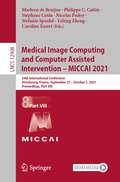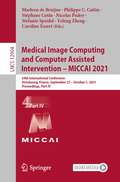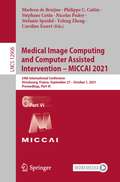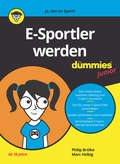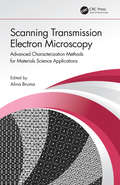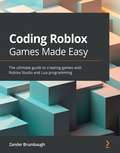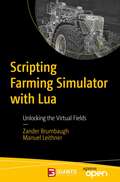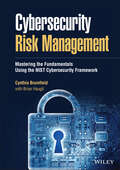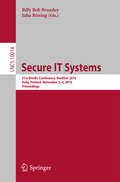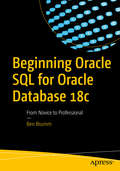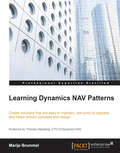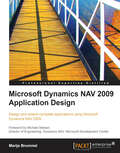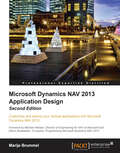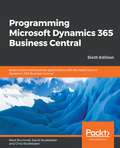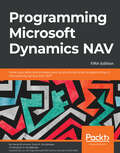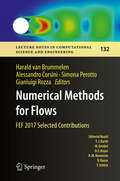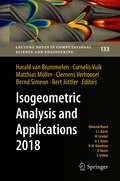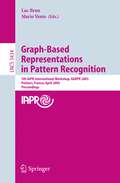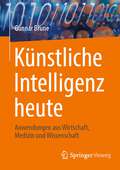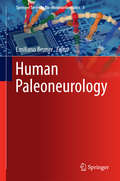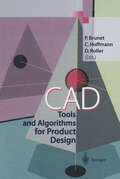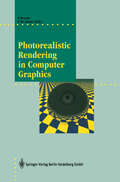- Table View
- List View
Medical Image Computing and Computer Assisted Intervention – MICCAI 2021: 24th International Conference, Strasbourg, France, September 27 – October 1, 2021, Proceedings, Part VIII (Lecture Notes in Computer Science #12908)
by Marleen De Bruijne Philippe C. Cattin Stéphane Cotin Nicolas Padoy Stefanie Speidel Yefeng Zheng Caroline EssertThe eight-volume set LNCS 12901, 12902, 12903, 12904, 12905, 12906, 12907, and 12908 constitutes the refereed proceedings of the 24th International Conference on Medical Image Computing and Computer-Assisted Intervention, MICCAI 2021, held in Strasbourg, France, in September/October 2021.*The 542 revised full papers presented were carefully reviewed and selected from 1809 submissions in a double-blind review process. The papers are organized in the following topical sections: Part I: image segmentation Part II: machine learning - self-supervised learning; machine learning - semi-supervised learning; and machine learning - weakly supervised learning Part III: machine learning - advances in machine learning theory; machine learning - domain adaptation; machine learning - federated learning; machine learning - interpretability / explainability; and machine learning - uncertainty Part IV: image registration; image-guided interventions and surgery; surgical data science; surgical planning and simulation; surgical skill and work flow analysis; and surgical visualization and mixed, augmented and virtual reality Part V: computer aided diagnosis; integration of imaging with non-imaging biomarkers; and outcome/disease prediction Part VI: image reconstruction; clinical applications - cardiac; and clinical applications - vascular Part VII: clinical applications - abdomen; clinical applications - breast; clinical applications - dermatology; clinical applications - fetal imaging; clinical applications - lung; clinical applications - neuroimaging - brain development; clinical applications - neuroimaging - DWI and tractography; clinical applications - neuroimaging - functional brain networks; clinical applications - neuroimaging – others; and clinical applications - oncology Part VIII: clinical applications - ophthalmology; computational (integrative) pathology; modalities - microscopy; modalities - histopathology; and modalities - ultrasound*The conference was held virtually.
Medical Image Computing and Computer Assisted Intervention – MICCAI 2021: 24th International Conference, Strasbourg, France, September 27–October 1, 2021, Proceedings, Part IV (Lecture Notes in Computer Science #12904)
by Marleen De Bruijne Philippe C. Cattin Stéphane Cotin Nicolas Padoy Stefanie Speidel Yefeng Zheng Caroline EssertThe eight-volume set LNCS 12901, 12902, 12903, 12904, 12905, 12906, 12907, and 12908 constitutes the refereed proceedings of the 24th International Conference on Medical Image Computing and Computer-Assisted Intervention, MICCAI 2021, held in Strasbourg, France, in September/October 2021.*The 542 revised full papers presented were carefully reviewed and selected from 1809 submissions in a double-blind review process. The papers are organized in the following topical sections: Part I: image segmentation Part II: machine learning - self-supervised learning; machine learning - semi-supervised learning; and machine learning - weakly supervised learning Part III: machine learning - advances in machine learning theory; machine learning - domain adaptation; machine learning - federated learning; machine learning - interpretability / explainability; and machine learning - uncertainty Part IV: image registration; image-guided interventions and surgery; surgical data science; surgical planning and simulation; surgical skill and work flow analysis; and surgical visualization and mixed, augmented and virtual reality Part V: computer aided diagnosis; integration of imaging with non-imaging biomarkers; and outcome/disease prediction Part VI: image reconstruction; clinical applications - cardiac; and clinical applications - vascular Part VII: clinical applications - abdomen; clinical applications - breast; clinical applications - dermatology; clinical applications - fetal imaging; clinical applications - lung; clinical applications - neuroimaging - brain development; clinical applications - neuroimaging - DWI and tractography; clinical applications - neuroimaging - functional brain networks; clinical applications - neuroimaging – others; and clinical applications - oncology Part VIII: clinical applications - ophthalmology; computational (integrative) pathology; modalities - microscopy; modalities - histopathology; and modalities - ultrasound*The conference was held virtually.
Medical Image Computing and Computer Assisted Intervention – MICCAI 2021: 24th International Conference, Strasbourg, France, September 27–October 1, 2021, Proceedings, Part VI (Lecture Notes in Computer Science #12906)
by Marleen De Bruijne Philippe C. Cattin Stéphane Cotin Nicolas Padoy Stefanie Speidel Yefeng Zheng Caroline EssertThe eight-volume set LNCS 12901, 12902, 12903, 12904, 12905, 12906, 12907, and 12908 constitutes the refereed proceedings of the 24th International Conference on Medical Image Computing and Computer-Assisted Intervention, MICCAI 2021, held in Strasbourg, France, in September/October 2021.*The 531 revised full papers presented were carefully reviewed and selected from 1630 submissions in a double-blind review process. The papers are organized in the following topical sections: Part I: image segmentation Part II: machine learning - self-supervised learning; machine learning - semi-supervised learning; and machine learning - weakly supervised learning Part III: machine learning - advances in machine learning theory; machine learning - attention models; machine learning - domain adaptation; machine learning - federated learning; machine learning - interpretability / explainability; and machine learning - uncertainty Part IV: image registration; image-guided interventions and surgery; surgical data science; surgical planning and simulation; surgical skill and work flow analysis; and surgical visualization and mixed, augmented and virtual reality Part V: computer aided diagnosis; integration of imaging with non-imaging biomarkers; and outcome/disease prediction Part VI: image reconstruction; clinical applications - cardiac; and clinical applications - vascular Part VII: clinical applications - abdomen; clinical applications - breast; clinical applications - dermatology; clinical applications - fetal imaging; clinical applications - lung; clinical applications - neuroimaging - brain development; clinical applications - neuroimaging - DWI and tractography; clinical applications - neuroimaging - functional brain networks; clinical applications - neuroimaging – others; and clinical applications - oncology Part VIII: clinical applications - ophthalmology; computational (integrative) pathology; modalities - microscopy; modalities - histopathology; and modalities - ultrasound*The conference was held virtually.
E-Sportler Werden für Dummies Junior (Für Dummies)
by Philip Brulke Marc HelbigIn diesem Buch erfährst du, wie aus "Daddeln" und "Zocken" professioneller E-Sport wird: Welches Spiel, welcher Titel passt zu dir? Wie und wann solltest du trainieren? Wie gehst du mit Niederlagen um? Was kannst du aus Fehlern lernen? Außerdem erfährst du, dass es neben dem Job als Spieler noch weitere Berufe im E-Sport gibt und wie du dich auf diese vorbereiten kannst. Und auch wenn du den E-Sport nicht als Profi betreiben und auch nicht in diesem Bereich arbeiten willst, wirst du beim Spielen einfach besser werden. Denn auch Hobbysportler wollen doch gewinnen, oder? Bestens geeignet für Kinder und Jugendliche ab 10 Jahren.
Scanning Transmission Electron Microscopy: Advanced Characterization Methods for Materials Science Applications
by Alina BrumaScanning Transmission Electron Microscopy is focused on discussing the latest approaches in the recording of high-fidelity quantitative annular dark-field (ADF) data. It showcases the application of machine learning in electron microscopy and the latest advancements in image processing and data interpretation for materials notoriously difficult to analyze using scanning transmission electron microscopy (STEM). It also highlights strategies to record and interpret large electron diffraction datasets for the analysis of nanostructures. This book: Discusses existing approaches for experimental design in the recording of high-fidelity quantitative ADF data Presents the most common types of scintillator-photomultiplier ADF detectors, along with their strengths and weaknesses. Proposes strategies to minimize the introduction of errors from these detectors and avenues for dealing with residual errors Discusses the practice of reliable multiframe imaging, along with the benefits and new experimental opportunities it presents in electron dose or dose-rate management Focuses on supervised and unsupervised machine learning for electron microscopy Discusses open data formats, community-driven software, and data repositories Proposes methods to process information at both global and local scales, and discusses avenues to improve the storage, transfer, analysis, and interpretation of multidimensional datasets Provides the spectrum of possibilities to study materials at the resolution limit by means of new developments in instrumentation Recommends methods for quantitative structural characterization of sensitive nanomaterials using electron diffraction techniques and describes strategies to collect electron diffraction patterns for such materials This book helps academics, researchers, and industry professionals in materials science, chemistry, physics, and related fields to understand and apply computer-science–derived analysis methods to solve problems regarding data analysis and interpretation of materials properties.
Scanning Transmission Electron Microscopy: Advanced Characterization Methods for Materials Science Applications
by Alina BrumaScanning Transmission Electron Microscopy is focused on discussing the latest approaches in the recording of high-fidelity quantitative annular dark-field (ADF) data. It showcases the application of machine learning in electron microscopy and the latest advancements in image processing and data interpretation for materials notoriously difficult to analyze using scanning transmission electron microscopy (STEM). It also highlights strategies to record and interpret large electron diffraction datasets for the analysis of nanostructures. This book: Discusses existing approaches for experimental design in the recording of high-fidelity quantitative ADF data Presents the most common types of scintillator-photomultiplier ADF detectors, along with their strengths and weaknesses. Proposes strategies to minimize the introduction of errors from these detectors and avenues for dealing with residual errors Discusses the practice of reliable multiframe imaging, along with the benefits and new experimental opportunities it presents in electron dose or dose-rate management Focuses on supervised and unsupervised machine learning for electron microscopy Discusses open data formats, community-driven software, and data repositories Proposes methods to process information at both global and local scales, and discusses avenues to improve the storage, transfer, analysis, and interpretation of multidimensional datasets Provides the spectrum of possibilities to study materials at the resolution limit by means of new developments in instrumentation Recommends methods for quantitative structural characterization of sensitive nanomaterials using electron diffraction techniques and describes strategies to collect electron diffraction patterns for such materials This book helps academics, researchers, and industry professionals in materials science, chemistry, physics, and related fields to understand and apply computer-science–derived analysis methods to solve problems regarding data analysis and interpretation of materials properties.
Coding Roblox Games Made Easy: The ultimate guide to creating games with Roblox Studio and Lua programming
by Zander BrumbaughGet up and running with Roblox development with the help of expert guidance for working with Roblox components and Lua programmingKey FeaturesDiscover solutions to common problems faced while creating games on RobloxExplore tips, tricks, and best practices and learn advanced Roblox coding techniques to create gamesUnderstand how to program in the Roblox Lua language, add engaging effects, add a variety of functionalities, and much moreBook DescriptionRoblox is a global virtual platform like no other for both playing and creating games. With well over 150 million monthly active users, Roblox hosts all genres of games that can be played by other members of the community using the Lua programming language. Not only can you create games for free, but you can also earn considerable sums of money if from the success of your games, and become part of the vast and supportive developer circle that provides excellent opportunities for networking in a tight-knit community. With this practical book, you'll get hands-on experience working on the Roblox platform. You'll start with an overview of Roblox development and then understand how to use Roblox Studio. As you progress, you'll gradually learn everything you need from how to program in Roblox Lua to creating Obby and Battle Royale games. Finally, you'll delve into the logistics of game production, focusing on optimizing the performance of your game by implementing impressive mechanics, monetization, and marketing practices. By the end of this Roblox book, you'll be able to lead or work with a team to bring your gaming world to life, and extend that experience to players around the world.What you will learnGet started with Roblox development and explore aspects such as choosing a developer typeUnderstand how to use Roblox Studio and other free resourcesCreate your first game with the Roblox Lua programming languageBecome well-versed with the three Ms - Mechanics, Monetization, and MarketingDevelop real-world games such as Battle Royale and ObbyDiscover expert tips for collaborating effectively and managing project workloadsWho this book is forThis Roblox guide is for anyone interested in learning how to develop games on the Roblox platform. If you're already familiar with Roblox and looking for tips, tricks, and Roblox and Lua best practices for efficient development, you'll find this book helpful.
Scripting Farming Simulator with Lua: Unlocking the Virtual Fields
by Zander Brumbaugh Manuel LeithnerCreate mods using the popular game Farming Simulator with Lua, a versatile scripting language that can run on various platforms and applications. This open access book is best suited for programmers who want to learn how to use Lua to write scripts that can enhance and extend the gameplay experience.You'll start by reviewing the basics of programming in Lua and then move on to advanced topics, such as object-oriented programming, vehicle and placeable specializations, network synchronization, and creating custom user interfaces. With step-by-step instructions and detailed explanations, you'll see how to create scripts that modify game mechanics and add new features to the game.The practical examples and projects are ideal for providing hands-on experience with Lua scripting. Whether you are a creator looking to take your skills to the next level or a game developer interested in learning a new programming language, Scripting Farming Simulator with Lua is the ultimate guide to mastering Lua scripting.What You'll LearnUnderstand the fundamentals of programming in LUAImplement a basic “Hello-World” modAdd a new graphical user interface to your modUse hook scripts to extend base game featuresPublish your mod on the official Farming Simulator ModHub Who This Book Is ForCreators who want to add new features to Farming Simulator; game developers who want to learn a new programming language for modding purposes, and anyone who wants to expand their knowledge of programming and scripting.
Cybersecurity Risk Management: Mastering the Fundamentals Using the NIST Cybersecurity Framework
by Cynthia BrumfieldCybersecurity Risk Management In Cybersecurity Risk Management: Mastering the Fundamentals Using the NIST Cybersecurity Framework, veteran technology analyst Cynthia Brumfield, with contributions from cybersecurity expert Brian Haugli, delivers a straightforward and up-to-date exploration of the fundamentals of cybersecurity risk planning and management. The book offers readers easy-to-understand overviews of cybersecurity risk management principles, user, and network infrastructure planning, as well as the tools and techniques for detecting cyberattacks. The book also provides a roadmap to the development of a continuity of operations plan in the event of a cyberattack. With incisive insights into the Framework for Improving Cybersecurity of Critical Infrastructure produced by the United States National Institute of Standards and Technology (NIST), Cybersecurity Risk Management presents the gold standard in practical guidance for the implementation of risk management best practices. Filled with clear and easy-to-follow advice, this book also offers readers: A concise introduction to the principles of cybersecurity risk management and the steps necessary to manage digital risk to systems, assets, data, and capabilities A valuable exploration of modern tools that can improve an organization’s network infrastructure protection A practical discussion of the challenges involved in detecting and responding to a cyberattack and the importance of continuous security monitoring A helpful examination of the recovery from cybersecurity incidents Perfect for undergraduate and graduate students studying cybersecurity, Cybersecurity Risk Management is also an ideal resource for IT professionals working in private sector and government organizations worldwide who are considering implementing, or who may be required to implement, the NIST Framework at their organization.
Cybersecurity Risk Management: Mastering the Fundamentals Using the NIST Cybersecurity Framework
by Cynthia BrumfieldCybersecurity Risk Management In Cybersecurity Risk Management: Mastering the Fundamentals Using the NIST Cybersecurity Framework, veteran technology analyst Cynthia Brumfield, with contributions from cybersecurity expert Brian Haugli, delivers a straightforward and up-to-date exploration of the fundamentals of cybersecurity risk planning and management. The book offers readers easy-to-understand overviews of cybersecurity risk management principles, user, and network infrastructure planning, as well as the tools and techniques for detecting cyberattacks. The book also provides a roadmap to the development of a continuity of operations plan in the event of a cyberattack. With incisive insights into the Framework for Improving Cybersecurity of Critical Infrastructure produced by the United States National Institute of Standards and Technology (NIST), Cybersecurity Risk Management presents the gold standard in practical guidance for the implementation of risk management best practices. Filled with clear and easy-to-follow advice, this book also offers readers: A concise introduction to the principles of cybersecurity risk management and the steps necessary to manage digital risk to systems, assets, data, and capabilities A valuable exploration of modern tools that can improve an organization’s network infrastructure protection A practical discussion of the challenges involved in detecting and responding to a cyberattack and the importance of continuous security monitoring A helpful examination of the recovery from cybersecurity incidents Perfect for undergraduate and graduate students studying cybersecurity, Cybersecurity Risk Management is also an ideal resource for IT professionals working in private sector and government organizations worldwide who are considering implementing, or who may be required to implement, the NIST Framework at their organization.
Secure IT Systems: 21st Nordic Conference, NordSec 2016, Oulu, Finland, November 2-4, 2016. Proceedings (Lecture Notes in Computer Science #10014)
by Billy Bob Brumley Juha RöningThis book constitutes the proceedings of the 21st Nordic Conference on Secure IT Systems, held in Oulu, Finland, in November 2016. The 16 full papers presented in this volume were carefully reviewed and selected from 43 submissions.The focus of the conference is on following topics: Security, System Security, Network Security, Software Security, and Information Security.
Beginning Oracle SQL for Oracle Database 18c: From Novice to Professional
by Ben BrummStart developing with Oracle SQL. This book is a one-stop introduction to everything you need to know about getting started developing an Oracle Database. You'll learn about foundational concepts, setting up a simple schema, adding data, reading data from the database, and making changes. No experience with databases is required to get started. Examples in the book are built around Oracle Live SQL, a freely available, online sandbox for practicing and experimenting with SQL statements, and Oracle Express Edition, a free version of Oracle Database that is available for download.A marquee feature of Beginning Oracle SQL for Oracle Database 18c is the small chapter size. Content is divided into easily digestible chunks that can be read and practiced in very short intervals of time, making this the ideal book for a busy professional to learn from. Even just a 15-20 minute block of free time can be put to good use.Author Ben Brumm begins by helping you understand what a database is, and getting you set up with a sandbox in which to practice the SQL that you are learning. From there, easily digestible chapters cover, point-by-point, the different aspects of writing queries to get data out of a database. You’ll also learn about creating tables and getting data into the database. Crucial topics such as working with nulls and writing analytic queries are given the attention they deserve, helping you to avoid pitfalls when writing queries for production use.What You'll LearnCreate, update, and delete tables in an Oracle databaseAdd, update, delete data from those database tablesQuery and view data stored in your databaseManipulate and transform data using in-built database functions and featuresCorrectly choose when to use Oracle-specific syntax and featuresWho This Book Is ForThose new to Oracle who are planning to develop software using Oracle as the back-end data store. The book is also for those who are getting started in software development and realize they need to learn some kind of database language. Those who are learning software development on the side of their normal job, or learning it as a college student, who are ready to learn what a database is and how to use it also will find this book useful.
Learning Dynamics NAV Patterns
by Mark BrummelCreate solutions that are easy to maintain, quick to upgrade, and follow proven concepts and designs About This Book • Design software that is maintainable outside the ecosystem of their creators • Ensure quality by following patterns that have been proved to work • Over two dozen practical Architectural and Design patterns Who This Book Is For Learning Dynamics NAV Patterns is intended for developers, architects, (technical) consultants, and application managers. You may have very little or no knowledge about NAV patterns, but you should be acquainted with programming. What You Will Learn • Apply object-oriented practices to C/AL programming • Structure your application to avoid merge conflicts • Refactor legacy code and avoid anti-patterns • Design decision trees to decide when to use which patterns • Clone codes and their application in Dynamics NAV • Make your application extensible by creating predefined hooks and facades In Detail Microsoft Dynamics NAV is a complete ERP system, which also contains a robust set of development tools to support customization and enhancement. These include an object designer for each of the seven application object types, a business application oriented programming language with .NET interface capability, a compiler, a debugger, and programming testing language support. Learning Dynamics NAV Patterns will guide you through the NAV way of solving problems. This book will first introduce you to patterns and the software architecture of the NAV and then help you to build an example application. Then, it walks you through the details of architectural patterns, design patterns, and implementation patterns. This book will also talk about anti-patterns and handling legacy code. Finally, it teaches you to build solutions using patterns. Proven patterns and best practices will help you create better solutions that are easy to maintain in larger teams across several locations. It will guide you through combining abstract patterns using easy-to-understand examples and will help you decide which patterns to use in which scenarios. Style and approach This book explains the concepts of patterns, code structuring, and object-oriented concepts in a way that is easy to understand for Dynamics NAV specialists through practical examples.
Learning Dynamics NAV Patterns
by Mark BrummelCreate solutions that are easy to maintain, quick to upgrade, and follow proven concepts and designs About This Book • Design software that is maintainable outside the ecosystem of their creators • Ensure quality by following patterns that have been proved to work • Over two dozen practical Architectural and Design patterns Who This Book Is For Learning Dynamics NAV Patterns is intended for developers, architects, (technical) consultants, and application managers. You may have very little or no knowledge about NAV patterns, but you should be acquainted with programming. What You Will Learn • Apply object-oriented practices to C/AL programming • Structure your application to avoid merge conflicts • Refactor legacy code and avoid anti-patterns • Design decision trees to decide when to use which patterns • Clone codes and their application in Dynamics NAV • Make your application extensible by creating predefined hooks and facades In Detail Microsoft Dynamics NAV is a complete ERP system, which also contains a robust set of development tools to support customization and enhancement. These include an object designer for each of the seven application object types, a business application oriented programming language with .NET interface capability, a compiler, a debugger, and programming testing language support. Learning Dynamics NAV Patterns will guide you through the NAV way of solving problems. This book will first introduce you to patterns and the software architecture of the NAV and then help you to build an example application. Then, it walks you through the details of architectural patterns, design patterns, and implementation patterns. This book will also talk about anti-patterns and handling legacy code. Finally, it teaches you to build solutions using patterns. Proven patterns and best practices will help you create better solutions that are easy to maintain in larger teams across several locations. It will guide you through combining abstract patterns using easy-to-understand examples and will help you decide which patterns to use in which scenarios. Style and approach This book explains the concepts of patterns, code structuring, and object-oriented concepts in a way that is easy to understand for Dynamics NAV specialists through practical examples.
Microsoft Dynamics NAV 2009 Application Design: A Focused Tutorial For Microsoft Dynamics Nav Application Development
by Mark BrummelThis book is a tutorial in an easy-to-read style. It will show Dynamics NAV developers how to create applications of different kinds with sufficient examples throughout. If you are a NAV consultant and developer, or designer of business applications you will benefit most from this book. The book assumes that you have a basic understanding of business management systems and application development, with a working knowledge of Microsoft Dynamics NAV.
Microsoft Dynamics NAV 2013 Application Design
by Mark BrummelIf you are a NAV consultant and developer or a designer of business applications, you will benefit most from this book. This book assumes that you have a basic understanding of business management systems and application development with working knowledge of Microsoft Dynamics NAV.
Programming Microsoft Dynamics 365 Business Central, Sixth Edition: Build Customized Business Applications With The Latest Tools In Dynamics 365 Business Central, 6th Edition
by Mark BrummelProgramming Microsoft Dynamics Business Central, Sixth Edition, will help you effectively use the development tools that are built into Dynamics Business Central. You will understand the strengths of Microsoft Dynamics 365 Business Central’s development tools and how they can be applied to address functional business requirements.
Programming Microsoft Dynamics NAV
by Mark BrummelMicrosoft Dynamics NAV is a full business solution suite, and a complete ERP solution, which contains a robust set of development tools to support customization and enhancement. These tools help in greater control over financials and can simplify supply chain, manufacturing, and operations. This book will take you from an introduction to Dynamics NAV and its integrated development tools to being a productive developer in the Dynamics NAV Development Environment.
Numerical Methods for Flows: FEF 2017 Selected Contributions (Lecture Notes in Computational Science and Engineering #132)
by Harald Van Brummelen Alessandro Corsini Simona Perotto Gianluigi RozzaThis book includes selected contributions on applied mathematics, numerical analysis, numerical simulation and scientific computing related to fluid mechanics problems, presented at the FEF-“Finite Element for Flows” conference, held in Rome in spring 2017. Written by leading international experts and covering state-of-the-art topics in numerical simulation for flows, it provides fascinating insights into and perspectives on current and future methodological and numerical developments in computational science. As such, the book is a valuable resource for researchers, as well as Masters and Ph.D students.
Isogeometric Analysis and Applications 2018 (Lecture Notes in Computational Science and Engineering #133)
by Harald Van Brummelen Cornelis Vuik Matthias Möller Clemens Verhoosel Bernd Simeon Bert JüttlerThis proceedings volume gathers a selection of outstanding research papers presented at the third Conference on Isogeometric Analysis and Applications, held in Delft, The Netherlands, in April 2018. This conference series, previously held in Linz, Austria, in 2012 and Annweiler am Trifels, Germany, in 2014, has created an international forum for interaction between scientists and practitioners working in this rapidly developing field. Isogeometric analysis is a groundbreaking computational approach that aims to bridge the gap between numerical analysis and computational geometry modeling by integrating the finite element method and related numerical simulation techniques into the computer-aided design workflow, and vice versa. The methodology has matured over the last decade both in terms of our theoretical understanding, its mathematical foundation and the robustness and efficiency of its practical implementations. This development has enabled scientists and practitioners to tackle challenging new applications at the frontiers of research in science and engineering and attracted early adopters for this his novel computer-aided design and engineering technology in industry. The IGAA 2018 conference brought together experts on isogeometric analysis theory and application, share their insights into challenging industrial applications and to discuss the latest developments as well as the directions of future research and development that are required to make isogeometric analysis an established mainstream technology.
Graph-Based Representations in Pattern Recognition: 5th IAPR International Workshop, GbRPR 2005, Poitiers, France, April 11-13, 2005, Proceedings (Lecture Notes in Computer Science #3434)
by Luc Brun Mario VentoMany vision problems have to deal with di?erent entities (regions, lines, line junctions, etc.) and their relationships. These entities together with their re- tionships may be encoded using graphs or hypergraphs. The structural inf- mation encoded by graphs allows computer vision algorithms to address both the features of the di?erent entities and the structural or topological relati- ships between them. Moreover, turning a computer vision problem into a graph problem allows one to access the full arsenal of graph algorithms developed in computer science. The Technical Committee (TC15, http://www.iapr.org/tcs.html) of the IAPR (International Association for Pattern Recognition) has been funded in order to federate and to encourage research work in these ?elds. Among its - tivities, TC15 encourages the organization of special graph sessions at many computer vision conferences and organizes the biennial workshop GbR. While being designed within a speci?c framework, the graph algorithms developed for computer vision and pattern recognition tasks often share constraints and goals with those developed in other research ?elds such as data mining, robotics and discrete geometry. The TC15 community is thus not closed in its research ?elds but on the contrary is open to interchanges with other groups/communities.
Künstliche Intelligenz heute: Anwendungen aus Wirtschaft, Medizin und Wissenschaft
by Gunnar BruneKünstliche Intelligenz wird schon heute in vielen Unternehmen angewendet. Und es werden immer mehr. Schon bald werden KI-Anwender starke Wettbewerbsvorteile erzielen, weil sie bessere Produkte anbieten, die haltbarer sind, effizienter produziert wurden und wahrscheinlich auch nachhaltiger sein werden. Diese Unternehmen haben also gleich mehrere Vorteile. Aber: Dies sind nur selten deutsche Unternehmen. Und es sind noch seltener deutsche Startups. In diesem Buch spricht Gunnar Brune mit Anwendern, Forschern und Investoren aus Wirtschaft, Medizin und Wissenschaft, um zu zeigen, wie Machine Learning und Künstliche Intelligenz erfolgreich und oft überraschend einfach zum Einsatz kommen (Applied AI). Die Lektüre bietet Informationen, Ansätze und Inspiration für den nutzbringenden Einsatz von Künstlicher Intelligenz heute.
Human Paleoneurology (Springer Series in Bio-/Neuroinformatics #3)
by Emiliano BrunerThe book presents an integrative review of paleoneurology, the study of endocranial morphology in fossil species. The main focus is on showing how computed methods can be used to support advances in evolutionary neuroanatomy, paleoanthropology and archaeology and how they have contributed to creating a completely new perspective in cognitive neuroscience. Moreover, thanks to its multidisciplinary approach, the book addresses students and researchers approaching human paleoneurology from different angles and for different purposes, such as biologists, physicians, anthropologists, archaeologists and computer scientists. The individual chapters, written by international experts, represent authoritative reviews of the most important topics in the field. All the concepts are presented in an easy-to-understand style, making them accessible to university students, newcomers and also to anyone interested in understanding how methods like biomedical imaging, digital anatomy and computed and multivariate morphometrics can be used for analyzing ontogenetic and phylogenetic changes according to the principles of functional morphology, morphological integration and modularity.
CAD Tools and Algorithms for Product Design
by Pere BrunetA look at important new tools and algorithms for future product modeling systems, based on a seminar at the International Conference and Research Center for Computer Science, Schloß Dagstuhl, Germany, presented by internationally recognised experts in CAD technology.
Photorealistic Rendering in Computer Graphics: Proceedings of the Second Eurographics Workshop on Rendering (Focus on Computer Graphics)
by Pere Brunet Frederik W. JansenPhotorealistic rendering strives to generate images from computer modeled scenes with an image quality as close to real life as possible. A major issue in rendering is simulation of local and global light reflection in a scene. Both ray tracing and radiosity algorithms capture only some of the possible light reflection phenomena. Recently developed two-pass algorithms combine the ray tracing and radiosity approaches and are able to capture the whole range of light reflection. This book is a collection of papers discussing the latest developments, including a new range of improvements, in stochastic sampling strategies, radiosity form factor calculation, and parallel processing for ray tracing and radiosity. A number of papers on rendering applications in interior design, lighting design, and remote sensing conclude the volume. The contributions are revised versions of papers originally presented at the Second Eurographics Workshop on Rendering, held in Barcelona, Spain, in May 1991. The book fully reflects the state of the art in rendering and presentsa wide variety of novel techniques. It will interest researchers and students in computer graphics, as well as designers who want to apply rendering techniques for realistic simulation in lighting design, interior design, and architecture.
